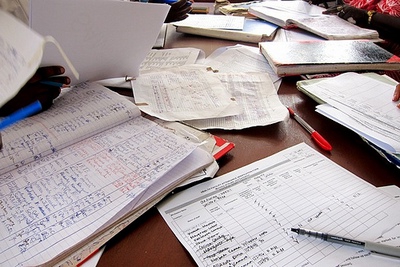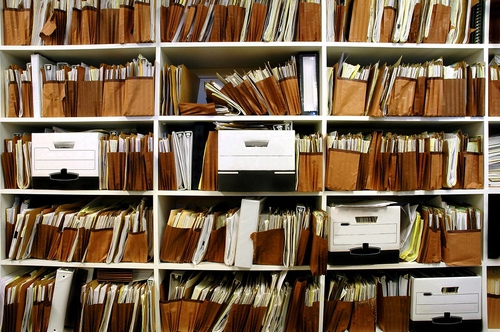Primary documents are material objects in which initial data are accumulated, obtained, in turn, during observations, development, research and other types of human activity. In many areas, such papers act as the basis for reporting. Let's consider further what forms of primary documents can be. 
General information
Primary documents are a confirmation of the legal validity of any operations or actions. In other words, they prove that this or that fact has taken place. Registration of primary documents is carried out at the time of the action or operation. Through these papers, the liability of specific performers is established.
Primary accounting documents
All business operations performed by the enterprise must be recorded in acquittals. They are accepted for accounting if compiled in the form present in the corresponding albums of the unified forms. These magazines comply with the PBU, approved by order of the Ministry of Finance No. 34. If necessary, additional columns and lines may be included in the forms of primary accounting documents. In this case, all the required details established by regulatory enactments must be kept. Corrections that will be made on the forms are confirmed by relevant orders and orders. The forms of primary accounting documents fixing cash transactions are not subject to change.
Codes
Unified primary documents are forms in which information is entered in accordance with the classifiers in force in the country. Some codes do not have references to these standards. They are designed to systematize and generalize data during processing by computer. Such operations are recorded according to the coding system approved by the enterprise.
Additionally
Unified forms developed directly by the company itself may also be accepted for accounting. They must also retain the mandatory details provided for other types of samples. The company itself can develop a list of primary documents not contained in the albums.
Mandatory details
The primary documents of the organization should contain:
- name;
- date of compilation;
- name of the company on whose behalf the form is filled out;
- an indication of the positions of persons responsible for the operation and its fixation.
All forms must be endorsed by those entities whose information is present in them. The certifying primary signature documents act as evidence of the authenticity and legal validity of the securities. 
Responsible persons
Primary accounting documents must be completed in a timely and correct manner. This task is carried out by persons who, in fact, compose and endorse them. Responsible employees also ensure timely transfer of papers to the accounting department for their subsequent reflection in reporting. Officials are required to enter only reliable information on the forms. The list of employees who can sign primary documents is approved by the management of the enterprise in agreement with the financial and settlement department. Papers recording business transactions relating to cash flow are directly endorsed by the director of the company.The chief accountant also has the right to sign these documents.
Classification
Primary documents are forms that are used in various areas of the enterprise. All these papers can be divided into:
- Organizational and administrative. These include orders, orders, powers of attorney, instructions and so on. All of them allow the implementation of certain operations.
- Acquittal. This category includes receipt warrants, requirements, invoices, acts of acceptance and so on. All these papers are documents of the primary accounting of transactions. The data that they contain is recorded in the respective registers.
- Forms of financial statements. These documents are used for accounting.
Some forms are simultaneously considered both acquittal and permissive. These, in particular, include payroll cash expense order and so on. 
Clerical work
A special schedule is being developed at the enterprise, in accordance with which the terms and procedure for the movement of primary documentation within the company, as well as its receipt in accounting, are determined. After the transfer of securities to the financial and settlement department, they are checked. In particular, it is monitored:
- The form of the document. An authorized employee checks the correctness and completeness of filling, the presence of mandatory details.
- Arithmetic fidelity of the calculations.
- Content. The documents should not contain internal contradictions, clearly see the relationship of certain indicators.
Registers
After the primary accounting documents are accepted, information from them is entered in special sheets. At the same time on the forms are marked, excluding their reuse. For example, a date is set. The accounting register is called special sheets for entering and organizing information. They are kept in special magazines or books, on separate cards and pages, in the form of typograms that are obtained using computers. Registers can be in the form of magnetic tapes, floppy disks, disks and other drives. The fixing of business operations is carried out in chronological order. All actions are grouped in the corresponding accounts. 
Types of Registers
Classification is carried out on various grounds. So, in appearance, the registers are divided into:
- Books (main, cash).
- Cards (for accounting materials, fixed assets, etc.).
- Magazines with printed or non-lined sheets.
Depending on the type of records that are produced, the registers may be:
- Systematic (general ledger of accounts).
- Chronological (registration books).
- Combined (warrants).
Regarding the level of detail of information distinguish registers:
- Combined (magazine-warrant).
- Synthetic (general ledger).
- Analytical (cards).
Important point
Information that is entered in the primary accounting documents must be recorded by means ensuring their safety for the time set for their storage in the archival department. Information may be in electronic or paper form. In the first case, the company is obliged at its own expense to produce copies of documents on paper. This is necessary to provide information to other participants in business operations, authorized supervisory authorities, the prosecutor's office and the court. 
Paper storage
Before submitting documents to the archive, they are grouped in chronological order, then they are completed and interwoven. All papers are filed in special folders. When submitting documentation to the archive, the corresponding certificate is filled out. During the storage of registers, their protection against unauthorized introduction of adjustments must be ensured. The information contained in the papers relates to the trade secret of the company. Persons with access to such documentation are not entitled to disclose information.For violation of trade secrets, those responsible are liable under the laws of the Russian Federation. The shelf life of the primary documentation, in accordance with Art. 17 Federal Law "On Accounting", is established according to the rules in force at the enterprise. Moreover, the period should not be less than 5 years.
Adjustments
If there is an error in the sheets, the latter should be corrected. Correction in this case is accompanied by a justification and is certified by the signature of the responsible employee with the date. Corrections to bank and cash papers are not allowed. The rest of the adjustment form shall be made only by agreement with other participants in business operations. This is confirmed by the signatures of the same employees who certified the documents. In this case, the date of adjustment is indicated. The props that will be corrected must be crossed out. The line should be thin but clear so that you can see the original value. Handwritten next to it is marked "Corrected Believe." The adjustment is certified by the signature of the employee who contributed it, indicating his name and initials. 
Paper Recovery
The legislation on accounting does not have clear rules that govern the procedure for re-compilation of documentation in case of its loss. Some other industry regulations also specify only retention periods. Due to the fact that the legislation does not establish what exactly it is necessary for the company to do when the primary documents are lost due to reasons beyond its control, the following recommendations are given in the letter of the UMNS:
- Appoint by order of the commission authorized to conduct an internal investigation into the causes of death, missing papers. If necessary, representatives of the state supervision, investigative bodies and security should be invited to its composition.
- To take measures permitted by law to restore those documents that are subject to updating and storage during the established time frames. For example, copies of statements on the movement of cash accounts can be obtained from service banking companies, counterparties can request invoices, acts, contracts, and so on.
However, far from always the company has the opportunity to ask for duplicates of all lost documents. So, for example, this can happen when there are a large number of contractors, due to the absence of buyers or suppliers at previously known addresses or due to the loss of contact information. Thus, there are fairly objective circumstances that can create certain obstacles to the restoration of documentation. At the same time, many managers have a logical question - should the tax authority be informed of what happened? According to some experts, it is not necessary to notify the inspection. In any case, this will not eliminate the probable liability. For the lack of primary documentation in the legislation provides a fine. This punishment is established, in particular, in Art. 120 NK. 
Possible solution to the problem
A taxpayer who, for one reason or another, has lost the original documentation, can do one of the following:
- Recover, if possible (at least partially) paper.
- Make corrective entries for expenses that are not documented and reflect the adjustments in revised declaration profit tax for the period. Costs not certified by securities are not recognized as expenses in tax reporting.
- Allow representatives of the tax service to establish the amounts to be paid to the budget when they check. This is done on the basis of data held by the entrepreneur, as well as information about other similar enterprises. This possibility is provided for in Art. 31, paragraph 1, paragraph 7 of the Tax Code.
Paper removal
This procedure can only be carried out by authorized authorities.These include, in particular, bodies of preliminary investigation, inquiries, prosecutors, tax inspectorates, courts, and police departments. The primary documentation is seized on the basis of decisions of these authorities adopted in the framework of the law. The letter of the Ministry of Finance No. 16/176 approved the instruction in accordance with which this procedure is carried out. Seizure of documentation is carried out in case of concealment or understatement by the taxpayer of income or other objects subject to taxation. Both the enterprise and the official and citizen can act as a violator. The chief accountant or other responsible employee of the company is allowed, with the consent and in the presence of representatives of the authorities making the seizure, to make copies of the primary documents indicating the date of this procedure.








